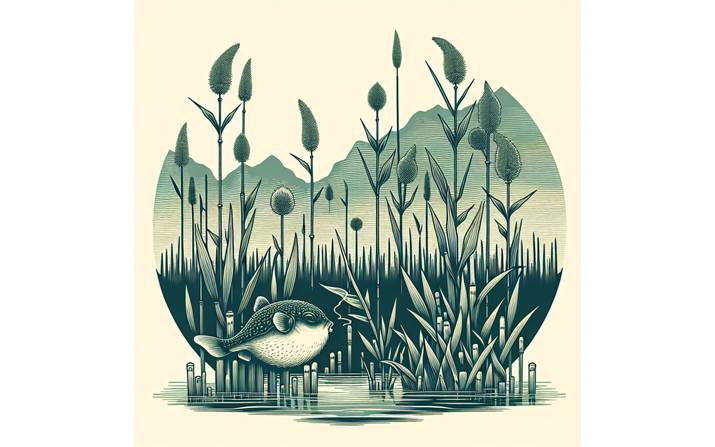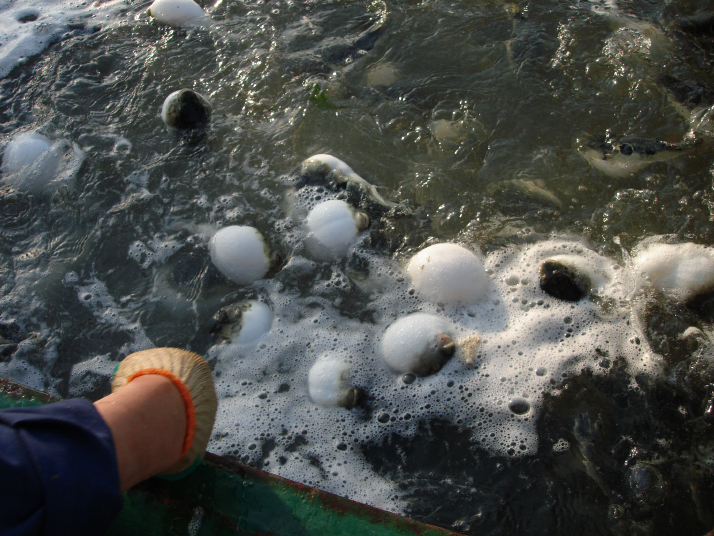| Business |
| The pufferfish industry is growing in China | |
|
|
 An illustration depicting the famous line from ancient Chinese poet Su Shi's poem, The land overrun by weeds and water studded with reeds, it's time for pufferfish to swim upstream (AI & TAO XING)
The land overrun by weeds and water studded with reeds, it's time for pufferfish to swim upstream. This is a line from a poem by Su Shi, a famous writer, calligrapher, painter and gourmet of the Northern Song Dynasty (960-1127). In 1085, Huichong, a painter and monk, invited Su to write a poem to accompany his painting River Scenes on a Spring Evening. Although there were no pufferfish in the artwork, Su's imagination of them into the scene has left him associated the delicacy to this day. The custom of eating pufferfish originated in China, where it's been consumed for thousands of years, according to Duan Ran, founder of Puffer Family, a Beijing-based business operating in all sections of the pufferfish industrial chain. "Chinese have been eating pufferfish since the reign of Emperor Yu the Great (about 2205-2197 B.C.). It was featured in imperial menus as early as the Tang Dynasty (618-907)," Duan told Beijing Review. However, pufferfish, known for their ability to inflate when threatened, have a dangerous reputation. Tetrodotoxin, a powerful neurotoxin found in almost all wild pufferfish, is lethal if eaten by humans. The toxins come from the diet of pufferfish and build up in their organs, with their ovaries and livers having the highest concentrations. Still, the fish is rich in protein, amino acids and unsaturated fatty acids, and is low in fat. Therefore, it can be used as a good source of nutrition for people. The poisonous yet tasty delicacy was banned from menus by China's health authorities in 1990. At that time, there were no related regulations or policies covering the farming, processing or consumption of the fish, resulting in deaths from poisoning. China only made consumption of farmed pufferfish legal in 2016. Since then, consumption of the fish has increased slowly. According to the China Aquatic Products Processing and Marketing Alliance, annual pufferfish consumption grew from more than 5,000 tons in 2017 to nearly 20,000 tons in 2021. The number of pufferfish restaurants in China has also increased from more than 100 in 2016 to more than 2,000. High industry requirements After 1993, many trials were conducted in China to find the methods of raising pufferfish with highly controlled diets that make them non-poisonous or less poisonous. For example, in that year, Zhongyang Group, an agricultural company based in Jiangsu Province, where there is a long-stranding custom of eating pufferfish, started the experimental breeding of non-toxic pufferfish. After more than 20 years of exploration and research, results show that the toxin content of farmed pufferfish has been significantly reduced and has reached a non-harmful level. After processing, the fish can safely be eaten. In September 2016, China's agricultural ministry and the food and drug administration jointly issued a document, allowing farming, processing and consumption of two species of pufferfish, Takifugu obscurus and Takifugu rubripes. There two species are both considered edible in Japan, which is the largest consumer of fugu, the Japanese name for pufferfish. Currently, pufferfish must be farmed and processed in facilities approved by the Ministry of Agriculture and Rural Affairs. The poison-free pufferfish are then delivered frozen to restaurants and supermarkets, with no live sales allowed. Inputs for pufferfish farming are also comparatively high, with the fish requiring higher water and feed quality than other stock. According to Duan, producing a kilogram of pufferfish costs farmers around 40 yuan ($5.54), much higher than the 5-6 yuan ($0.7-0.8) needed to produce a kilogram of grass carp. The stocking density in ponds also needs to be lower than for other farmed fish. Usually, in the same volume of water, pufferfish production capacity is one sixth of that of grass carp. "Pufferfish attack and injure one another if the density is high," Duan explained.  Pufferfish at the farm operated by Puffer Family in Tangshan, Hebei Province (COURTESY PHOTO)
Increased production China's pufferfish farming began in the early 1980s, and large-scale farming began in the mid-1990s. Before the consumption ban was lifted in 2016, Chinese farmed pufferfish were mostly exported to Japan and the Republic of Korea, which legalized the consumption of pufferfish much earlier than China. Since 2016, production of pufferfish in China has increased gradually. Data from the 2023 China Fishery Yearbook showed that, in 2022, the output of pufferfish farming in freshwater was 14,434 tons, and in seawater was 16,626 tons. "The entire domestic farming and sales volume is steadily increasing at a rate of over 30 percent year on year," Duan said. Pufferfish farming is mainly distributed along the coast from the southern provinces of Guangdong and Fujian to the northern provinces of Hebei and Liaoning. According to Duan, Puffer Family now has an approved pufferfish farm in Tangshan, Hebei, another in Zhongshan, Guangdong, and a processing facility in Beijing, which can process both of the approved species. Their two farms produce approximately 300 tons of the fish every year, valued at 20-30 million yuan ($2.76-4.85 million). In addition to farming companies, there are fishermen who also breed pufferfish to increase their incomes. According to the pufferfish branch of the China Fisheries Association, there are more than 4,000 households directly engaged in pufferfish farming in the Yangtze River region and along the coast of north China's Bohai Sea. Duan's company also cooperates with local farmers. "If they raise fry provided by me with feed provided by me, and raise them to my requirements and standards, I offer them a guaranteed purchase price," Duan told Beijing Review. Cooperation with farmers adds 233 hectares of ponds to the company's production capacity, with a value of around 200 million yuan ($27.6 million). Huge market potential "The farmers have the capacity to quickly increase production. The main issue now is how to increase consumption," Duan said. After the 26-year ban on eating pufferfish, there are now very few chefs who know how to cook them. Duan, who holds a PhD in agricultural environmental studies, was among the earliest to join the industry. His company operates several restaurants in Beijing, under the brand April Puffer. The restaurant's name was chosen as April is usually considered the best time to eat pufferfish. Part of Duan's efforts to build the market for his product involves training chefs and developing new pufferfish dishes. Detailing the cooking requirements for pufferfish, Duan said although farmed pufferfish are no longer poisonous, the possibility of trace amounts of toxin or of wild fish being present in farmed populations means vigilance is still necessary. "We still have to follow the same treatment standards we would for wild pufferfish and remove the potentially toxic parts," Duan said. "We took the lead in writing the national standards and technical specifications for Chinese traditional pufferfish cooking," Duan said. Over approximately 10 years of development, his company has developed more than 100 new pufferfish dishes, and also provides precooked dishes to other restaurants. When more restaurants are able to cook and sell pufferfish dishes, the market share will increase, Duan said. In recent years, Duan has also tried to explore the B2C model, selling directly to consumers. Previously, they mainly provided pufferfish products to other restaurants, but are now working to build cooperation with Freshippo, the grocery and fresh goods retail chain under Alibaba Group, allowing consumers to buy precooked pufferfish products directly. Puffer Family is now building a factory in Guangdong to produce precooked pufferfish dishes. The company is also conducting research into non-culinary applications for pufferfish, including pufferfish facial masks and dried, processed pufferfish skin, which is used to promote stomach health in traditional Chinese medicine. "I hope more consumers will come to know about pufferfish and the industry," Duan said. (Print Edition Title: Getting Puffed Up) Copyedited by G.P. Wilson Comments to taoxing@cicgamericas.com |
|
||
|
||||||||||||||||||||||||||||
|
